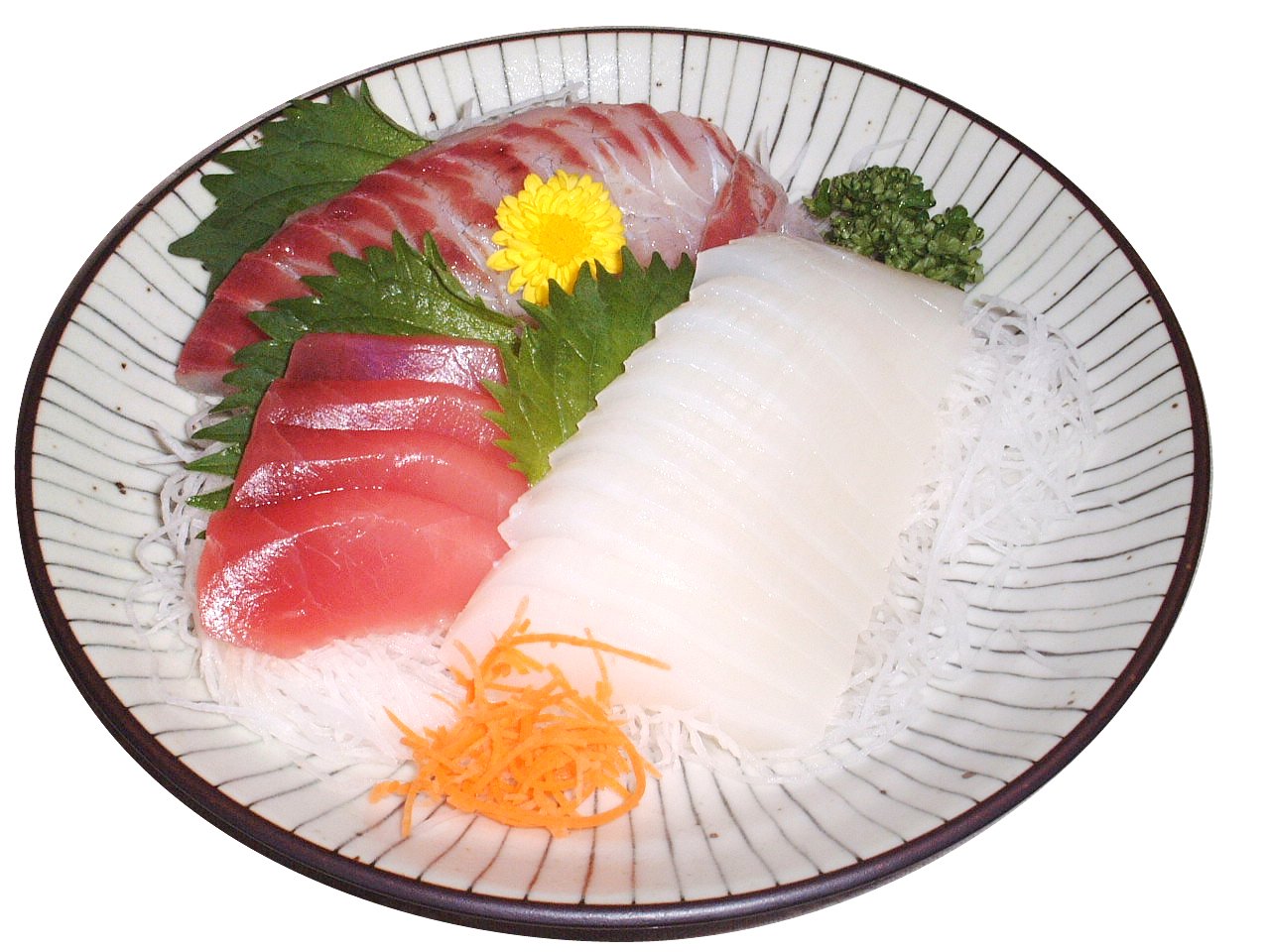Sashimi
Sashimi (刺身) is a Japanese dish consisting of fresh, raw fish or seafood that is sliced into thin pieces and served with soy sauce and wasabi. The word "sashimi" means "pierced body," which refers to the traditional method of slicing the fish into long, thin pieces.
History[edit | edit source]
Sashimi has been a part of Japanese cuisine for centuries. It is believed to have originated in the Kansai region of Japan, where fishermen would slice the fresh catch of the day and eat it with soy sauce and wasabi. Over time, the dish became popular throughout Japan and eventually spread to other parts of the world.
Preparation[edit | edit source]
To prepare sashimi, the fish must be extremely fresh and of high quality. It is typically served raw, although some varieties may be lightly seared or marinated in vinegar. The fish is sliced into thin pieces using a very sharp knife and arranged on a plate. Soy sauce and wasabi are served on the side for dipping.
Varieties[edit | edit source]
There are many different types of fish and seafood that can be used to make sashimi. Some popular varieties include:
Tuna (maguro) Salmon (sake) Yellowtail (hamachi) Sea bream (tai) Squid (ika) Octopus (tako) Scallop (hotate) Eel (unagi)
Serving[edit | edit source]
Sashimi is typically served as an appetizer or a main course in a Japanese meal. It is often accompanied by a bowl of rice, miso soup, and other side dishes. In Japan, sashimi is traditionally eaten with chopsticks, although it is also acceptable to eat it with the hands.
Health benefits[edit | edit source]
Sashimi is a low-calorie, high-protein food that is rich in omega-3 fatty acids and other nutrients. However, it is important to note that eating raw fish carries a risk of foodborne illness, particularly if the fish is not fresh or has not been properly handled and prepared.
Trivia[edit | edit source]
In Japan, sashimi is often eaten as part of a celebration or special occasion, such as a wedding or New Year's feast. Sashimi is sometimes served on a bed of ice to keep the fish cold and fresh. In Japanese cuisine, sashimi is often paired with sake or beer.
Etymology[edit | edit source]
The word "sashimi" is derived from the Japanese words "sashi" (刺し) meaning "pierced" and "mi" (身) meaning "body." This refers to the traditional method of slicing the fish into thin pieces, which involves piercing it with a sharp knife.
Popular culture[edit | edit source]
Sashimi has appeared in various forms of media and popular culture. It is often depicted in Japanese art, including ukiyo-e prints and paintings. In addition, sashimi has been featured in numerous films and television shows, including the Japanese drama series "Midnight Diner" and the anime series "Food Wars!".
Gallery[edit | edit source]
Controversy[edit | edit source]
There has been some controversy surrounding the consumption of sashimi, particularly in regard to the ethics of eating raw fish. Some environmental groups have raised concerns about overfishing and the impact of commercial fishing on the environment. In addition, there have been cases of foodborne illness associated with the consumption of raw fish, particularly in the United States.
Conclusion[edit | edit source]
Sashimi is a popular Japanese dish that consists of fresh, raw fish or seafood that is sliced into thin pieces and served with soy sauce and wasabi. It is typically served as an appetizer or a main course in a Japanese meal and is often accompanied by rice and other side dishes. While sashimi is a healthy and nutritious food, it is important to ensure that the fish is fresh and has been properly handled and prepared to minimize the risk of foodborne illness.
References[edit | edit source]
External links[edit | edit source]
Sashimi at Japan Guide 10 Delicious Types of Sashimi at Eat the Globe
The art of making sashimi is in the choice of fish and the way it is cut into pieces.
Related pages[edit | edit source]
See also[edit | edit source]
Sushi Poke
Other websites[edit | edit source]
Search WikiMD
Ad.Tired of being Overweight? Try W8MD's physician weight loss program.
Semaglutide (Ozempic / Wegovy and Tirzepatide (Mounjaro / Zepbound) available.
Advertise on WikiMD
|
WikiMD's Wellness Encyclopedia |
| Let Food Be Thy Medicine Medicine Thy Food - Hippocrates |
Translate this page: - East Asian
中文,
日本,
한국어,
South Asian
हिन्दी,
தமிழ்,
తెలుగు,
Urdu,
ಕನ್ನಡ,
Southeast Asian
Indonesian,
Vietnamese,
Thai,
မြန်မာဘာသာ,
বাংলা
European
español,
Deutsch,
français,
Greek,
português do Brasil,
polski,
română,
русский,
Nederlands,
norsk,
svenska,
suomi,
Italian
Middle Eastern & African
عربى,
Turkish,
Persian,
Hebrew,
Afrikaans,
isiZulu,
Kiswahili,
Other
Bulgarian,
Hungarian,
Czech,
Swedish,
മലയാളം,
मराठी,
ਪੰਜਾਬੀ,
ગુજરાતી,
Portuguese,
Ukrainian
Medical Disclaimer: WikiMD is not a substitute for professional medical advice. The information on WikiMD is provided as an information resource only, may be incorrect, outdated or misleading, and is not to be used or relied on for any diagnostic or treatment purposes. Please consult your health care provider before making any healthcare decisions or for guidance about a specific medical condition. WikiMD expressly disclaims responsibility, and shall have no liability, for any damages, loss, injury, or liability whatsoever suffered as a result of your reliance on the information contained in this site. By visiting this site you agree to the foregoing terms and conditions, which may from time to time be changed or supplemented by WikiMD. If you do not agree to the foregoing terms and conditions, you should not enter or use this site. See full disclaimer.
Credits:Most images are courtesy of Wikimedia commons, and templates, categories Wikipedia, licensed under CC BY SA or similar.
Contributors: Kondreddy Naveen





